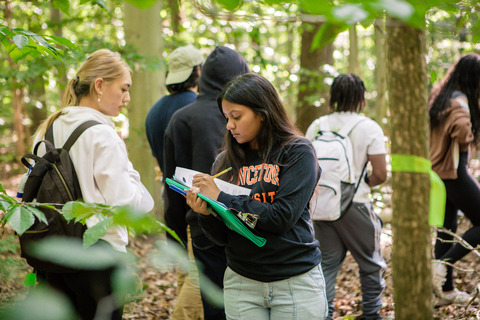Institute as Neighbor
From its earliest days, the Institute for Advanced Study has sought to cultivate a sense of community and discovery that extends beyond its campus.

It maintains 589 acres of open woodland, wetlands, and farmland—including the Institute Woods—that provide a backdrop for contemplation and discussion for the general public and for generations of scholars from Albert Einstein and J. Robert Oppenheimer onward (as well as their counterparts in the Oscar-winning Oppenheimer film).
The Institute also welcomes the greater Princeton community to attend regular, free events such as lectures, book talks, and film screenings, which cover a wide range of subjects from both the sciences and the humanities. In addition to this, it hosts an evolving program of performances by world-renowned artists, offering opportunities for all to engage in creative dialogue. Members of the public are also frequently invited to other diverse and enriching experiences on campus. Recordings of many of these offerings are freely available on the Institute’s YouTube channel.
The Shelby White and Leon Levy Archives Center, which documents, collects, and sustains the history of IAS, makes resources available to all who are interested, within and outside of the Institute community. In-person visits to the collections, and to the regularly rotating exhibitions curated by the Archives Center, can be arranged by contacting archives@ias.edu. Digitized materials can also be viewed on Albert, the Institute’s digital repository.

Historically, IAS played a key role in the founding of the nearby Princeton Battlefield State Park and has a long history of supporting its preservation and expansion. The Park commemorates a decisive clash between British and American forces on January 3, 1777. In the early 1950s, the Institute leased land to the State to increase the size of the park, and in 1973, it conveyed thirty-two acres to the State to enlarge the size of the park by 60 percent. At this time, it also worked with New Jersey’s Department of Environmental Protection to create a boundary for the Park, which serves as a historical buffer zone.
In 1959, the Institute donated the former Mercer Manor monumental portico that now stands on the Battlefield north of Mercer Road, commemorating the common grave of unknown American and British soldiers who fell during the Battle of Princeton. In 2018, the Civil War Trust, through its Campaign 1776 initiative to protect Revolutionary War battlefields, purchased almost fifteen acres of land from the Institute, which were conveyed to the State of New Jersey as a further addition to the Park.
The Institute is proud to be a part of Princeton’s distinguished history and remains committed to playing a steadfast role in engaging the public with its foundational discoveries.
